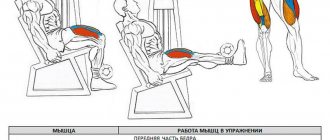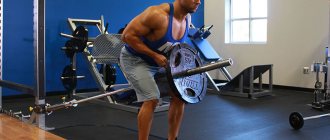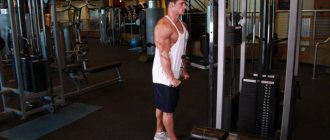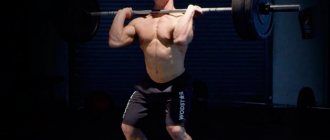It's hard to find any runners who don't want to run faster. Amateurs and professionals, juniors and senior athletes - everyone wants to increase their running speed. Why does it depend? How to learn to run fast? If we abstract from the relief and weather conditions, then there are only two factors: genetics and training.
Our genes encode information that will determine the functioning of all cells, organs and the body as a whole. How fast will the athlete's muscles be? How will the cardiovascular system react to physical activity? Why are some people better at short distance running, while others are better at long distance running? If we abstract from the terrain and weather conditions, then running speed depends on only two factors: genetics and training.
Further:
Muscles and heredity
There are about 600 muscles in the human body, most of which are used during running. Skeletal muscle itself is a bundle of thin longitudinal fibers - myofibrils, which include the contractile proteins actin and myosin, which provide movement. Myofibrils come in several types, the ratio of which in the muscle is determined by heredity. To a large extent, a person’s speed performance and his “prospects” not only in running, but also in other sports will depend on this ratio.
Slow and fast muscle fibers
Based on the speed of contraction, a distinction is made between “slow twitch” or slow (ST from English slow twitch) and “fast twitch” or fast (FT from English fast twitch) muscle fibers.
Slow or ST fibers
Thin, relatively weak, but at the same time resistant to fatigue. They are well supplied with blood and have a higher amount of myoglobin, which gives them their characteristic red color (red fibers). ST fibers contain many mitochondria and are characterized by high levels of aerobic enzyme activity. The amount of ATPase enzyme is small, which causes the low rate of contraction. Slow fibers are most adapted to static or prolonged monotonous loads of low intensity: maintaining a pose, light running.
Fast or FT fibers
Fast-twitch fibers are thicker than ST fibers and produce more force but also fatigue more quickly. These fibers are less perfused and have less mitochondria, lipids, and myoglobin than ST fibers (described as white fibers). Unlike slow fibers, fast fibers contain mainly enzymes for anaerobic glucose oxidation (glycolysis). Glycogen (carbohydrates) and creatine reserves are used as the main sources of energy. Due to their high contraction speed and rapid fatigue, these fibers are capable of short-term and high-intensity work: fast running, 100m sprint, for example.
Fast fibers can be divided into two subtypes. Their difference is in the method of obtaining energy: the first ( subtype A ) can use oxygen to obtain energy by oxidizing carbohydrates and fats, the second ( subtype B ) practically do not use oxygen.
The predominance of FT or ST muscle fibers will largely determine the speed potential of the athlete. If there are more fast myofibrils in the body, you can achieve high results in short-distance running, as well as in sprint swimming, weightlifting, martial arts and other sports disciplines, where the impulse, explosive work that FT provides is primarily important. muscle fibers. If slow-twitch muscle fibers predominate, there will be much more prospects in long-distance running, as well as: in long-distance swimming, road cycling, cross-country skiing, rowing, triathlon, etc., that is, in those sports where aerobic activity plays a major role. energy generation system.
In most people, the ratio of different types of myofibrils in muscles is approximately the same: 50 to 50%. But this is no reason to despair. Firstly, you can try to develop in sprinting or long-distance running, gradually adapting your muscles and your body through training. And secondly, middle-distance running, cross-country, as well as middle-distance swimming, many team sports (football, basketball, etc.) and even... chess are well suited. After all, this will have much more health benefits than TV, social networks or complaining about bad heredity.
Elite sprinters can have up to 80% fast myofibers in their muscles, while marathon runners, on the contrary, have up to 80% slow ones. But potential is only a more favorable starting position. Without training, he remains a potential!
Nutrition before the race
How to quickly run 3 km on a full stomach or without glycogen reserves? - No way!
Be sure to eat slow carbohydrates 2-3 hours before the competition: porridge, hard pasta. Try to eat foods that are familiar to your body.
An unusual lunch + exercise can put double stress on the gastrointestinal tract. Food will be less digestible, and the body will spend a lot of energy.
Can the number and ratio of ST and FT fibers in the body change?
The data is not yet final. Some studies show that the ratio of ST and FT myofibrils does not change as a result of training and is completely determined by genetics. Other studies show that aerobic training increases the content of slow myofibers. True, such changes are very limited and do not exceed 10%.
At the same time, during training, the number of mitochondria in the muscles can change, and, accordingly, their ability to generate energy with the participation of oxygen. It is also important for speed, especially over long distances. In addition, training leads to muscle fiber hypertrophy and the percentage of muscles will also change.
In untrained people, fast fibers are usually glycolytic, that is, type B predominates, and slow fibers are oxidative. This will be enough for mini-sprint races of 20-30 m to the bus stop or, for example, to the entrance from the meeting with the neighbor's dog. But of course, it is absolutely not enough for competitive sprinting and, especially, fast running over medium and long distances. There is no way without targeted training.
Mitochondria are unique organelles in which glucose or fatty acid molecules are broken down through a cascade of reactions into carbon dioxide and water, resynthesizing ATP necessary for muscle contraction. At the same time, it does not form lactic acid molecules, which “acidify” the muscle, as during glycolysis. Due to the appearance of additional mitochondria, fast muscle fibers in their oxidative potential are converted from glycolytic to intermediate, and the transition of intermediate fibers to oxidative is also possible.
Even if your genetics don’t work out, by training regularly you can significantly improve your performance and achieve good and sometimes excellent results!
Requirements for an athlete for a distance of 200 meters
The 200m sprint places high demands on the athlete. In order to reach maximum speed as soon as possible from the start, and then maintain it for at least most of the distance, the runner must be well prepared physically, have strength and good coordination .
To perform successfully, the athlete must have a height of 165-195 cm, the optimal height is 175 cm.
The ideal weight for a sprinter is considered to be height minus 102 kg. If an athlete’s height is 180 cm, then his weight should be 78 kg. In this case, there should be no fat pad, only dry muscles. In addition, the athlete must have a good metabolism. It must be able to spend and save glycogen.
The stronger the athlete, the higher his running speed . A sprinter must perform a chest press of 130 kg, a squat of 230 kg, and a leg press of 460 kg. The sprinter must deadlift with a load of 210 kg. These are ideal indicators.
Maximum oxygen consumption
The role of muscles in ensuring speed qualities is great, but, of course, not absolute. After all, in order for muscles, as well as other vital organs, to receive oxygen, the coordinated work of the respiratory and cardiovascular systems is necessary.
The most well-known indicator describing the connection and efficiency of these systems and muscles is maximum oxygen consumption (VO2 max), which shows the amount of oxygen (in milliliters) that a person is able to consume within 1 minute.
On average, MOC in young untrained men is 45 ml/min/kg, in women – 38 ml/min/kg.
As a result of training, not only does the number of mitochondria in the muscles increase, but also physiological adaptations occur such as an increase in blood plasma volume, systolic heart volume and stroke volume, tissue capillarization and, ultimately, such adaptations cause an improvement in the efficiency of oxygen transport to muscle cells and its use, and this is the key to improving performance in medium and long distance races.
MOC depends on genetic factors, age, gender, and is also closely related to muscle mass and quite accurately reflects the level of training.
Up to 20 years of age, the MIC value increases, from 25 to 35 years of age there is stabilization, and from 35 years of age there is a gradual decrease in MIC.
By age 65, maximum oxygen consumption decreases by about a third.
Recommendations from professionals
Professionals emphasize that the sprinter experiences enormous loads, so safety precautions must be observed:
- Before the start, you should definitely warm up - it’s best to jog for 10 minutes, do squats and bends so that your body and muscles warm up and get ready for running.
- Do a cool-down - immediately after completing the distance, you need to start jogging, and then walk, and move until your pulse and breathing return to normal.
- Choose the right shoes and clothes - clothes should not restrict the athlete’s movement, and shoes should have shock-absorbing soles, good heel support and comfortable lacing.
Not every athlete can do sprinting; some use it only as training. But in any case, this running discipline allows you to overcome yourself and discover new capabilities of your body.
Economy of running
Although knowledge of VO2 max will be quite informative, in long-distance competitions what is more important is not the maximum that can be squeezed out of oneself, but the submaximal speed that the athlete can maintain throughout the entire distance. And this speed will depend on MIC, and on the ability to utilize fats, the ability of buffer systems to fight “acidification” with lactate, on running technique, which allows optimal use of the body’s resources, breathing, etc. Actually, all this is united by such an integral concept as running economy . Running economy can vary among runners with the same VO2 max by up to 20%. In well-trained athletes with similar VO2 max values, running economy is the best predictor of performance.
Therefore, it is the increase in running economy that will improve performance, and therefore speed, in long-distance runners.
Summarizing the above, I would like to emphasize that an athlete’s running speed will be largely determined by his genetics.
At the same time, proper training can significantly increase running speed due to adaptation processes occurring in the muscles, respiratory and cardiovascular systems.
Features of training
The result of increasing running speed will not last long if the following are completed:
- There is a specific goal (overcoming a distance in a certain time).
- Constant courses with full dedication.
- There is a training program.
Leg muscles are important for running speed. Therefore, you should include leg strength exercises in your course.
The second point is jumping, the ability to push and accelerate when jumping. It is necessary to perform not only static, but also dynamic exercises.
To feel the speed, you must accelerate, for example, 60 - 150 m to the finish line. Many coaches advise not to forget to include speed, jumping and strength exercises in your training, as well as to practice your running technique by performing SBU.
Interview with Dmitir Nikolaychuk
What exercises do athletes use in practice to develop running speed? How can amateur runners increase their running speed?
Professional athletes are best versed in matters of speed development. Dmitry Nikolaychuk shared approaches and “secrets” for learning to run fast .
- Hello, Dima! Our readers will be interested in learning about the experience of a professional athlete. Please tell us what approaches are used to develop speed among amateurs?
– It’s hard to call me a professional athlete. I would say that I am simply a professional, since my main job is scientific activity plus coaching practice, which, however, does not at all prevent me from competing at official competitions. Although after each podium at the National Championships, the club and coach tell me that it’s enough to mock others with this approach and way of life.
- So here it is. The main approach when working with amateurs is to do no harm.











